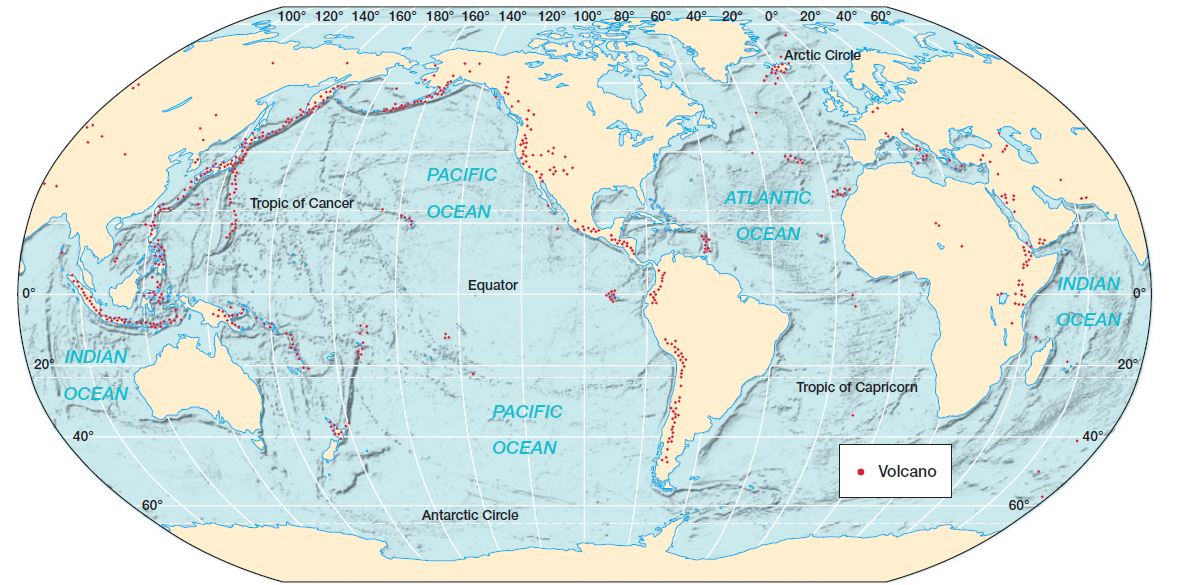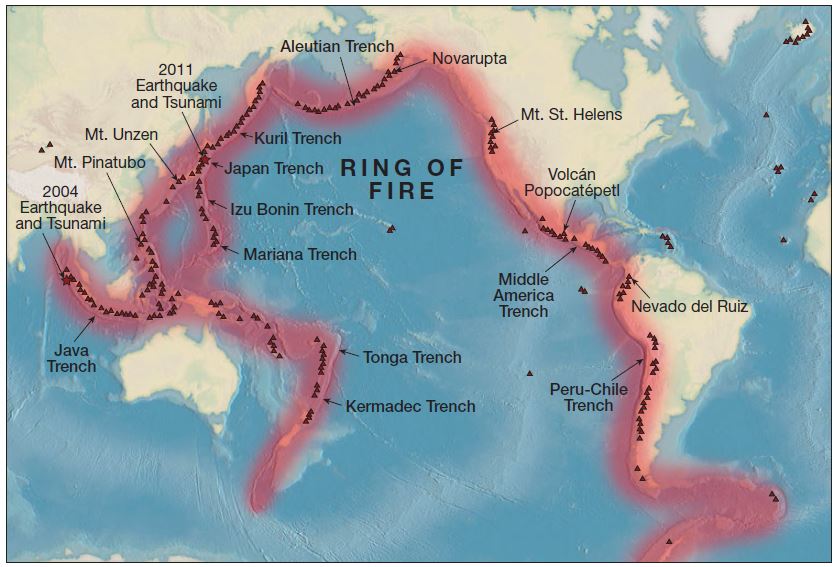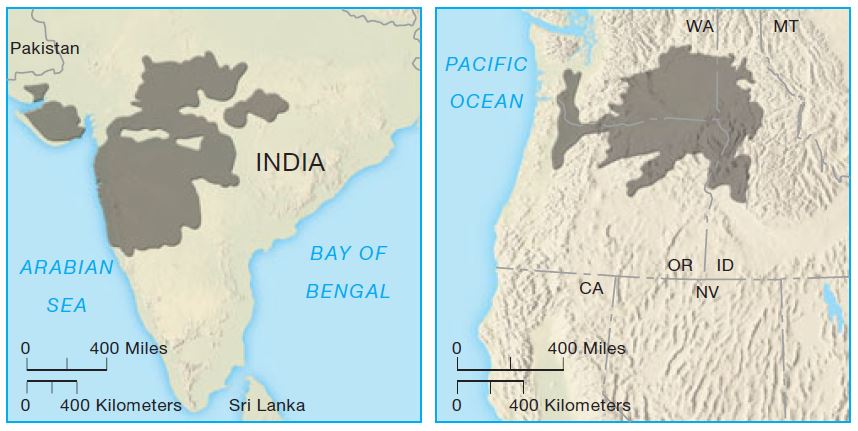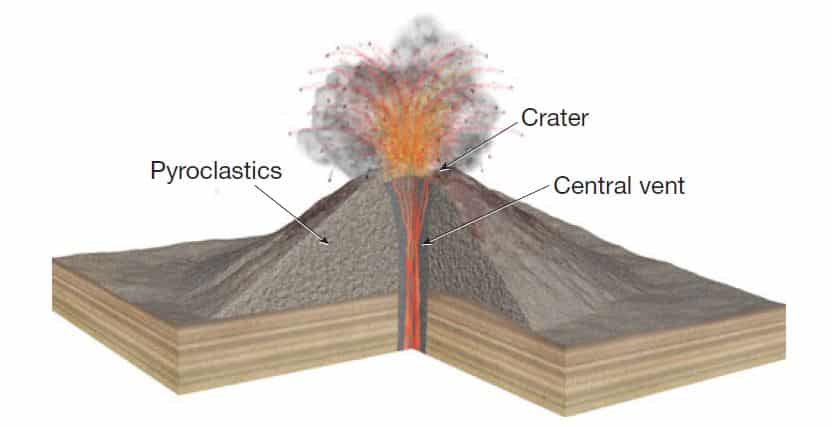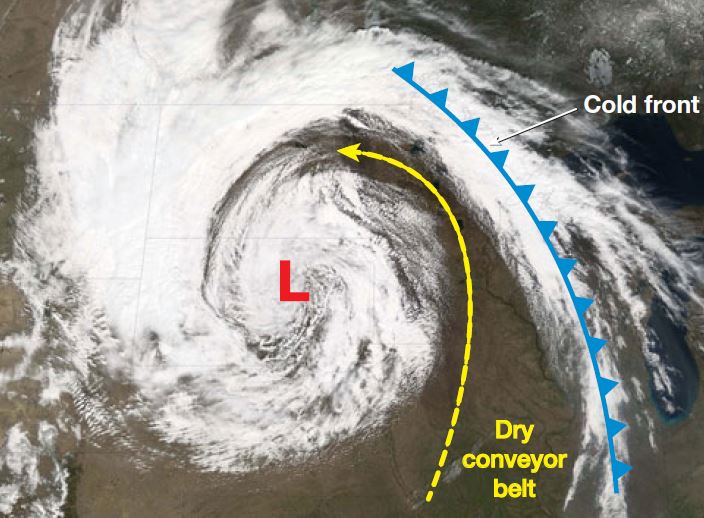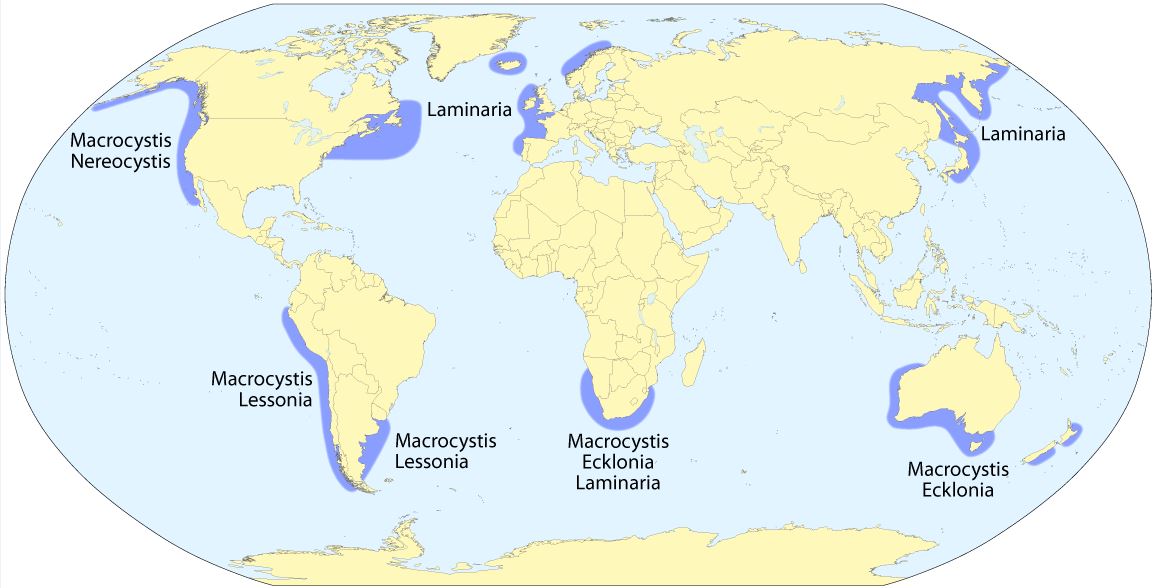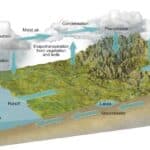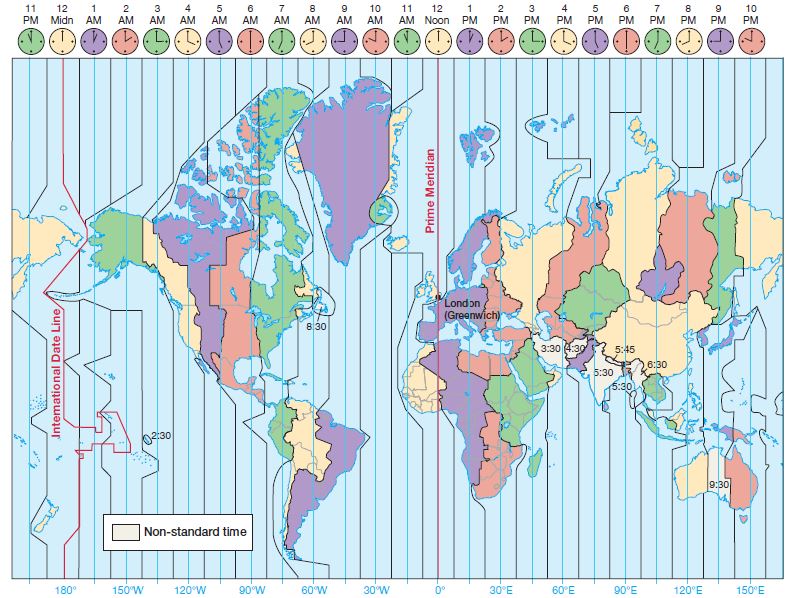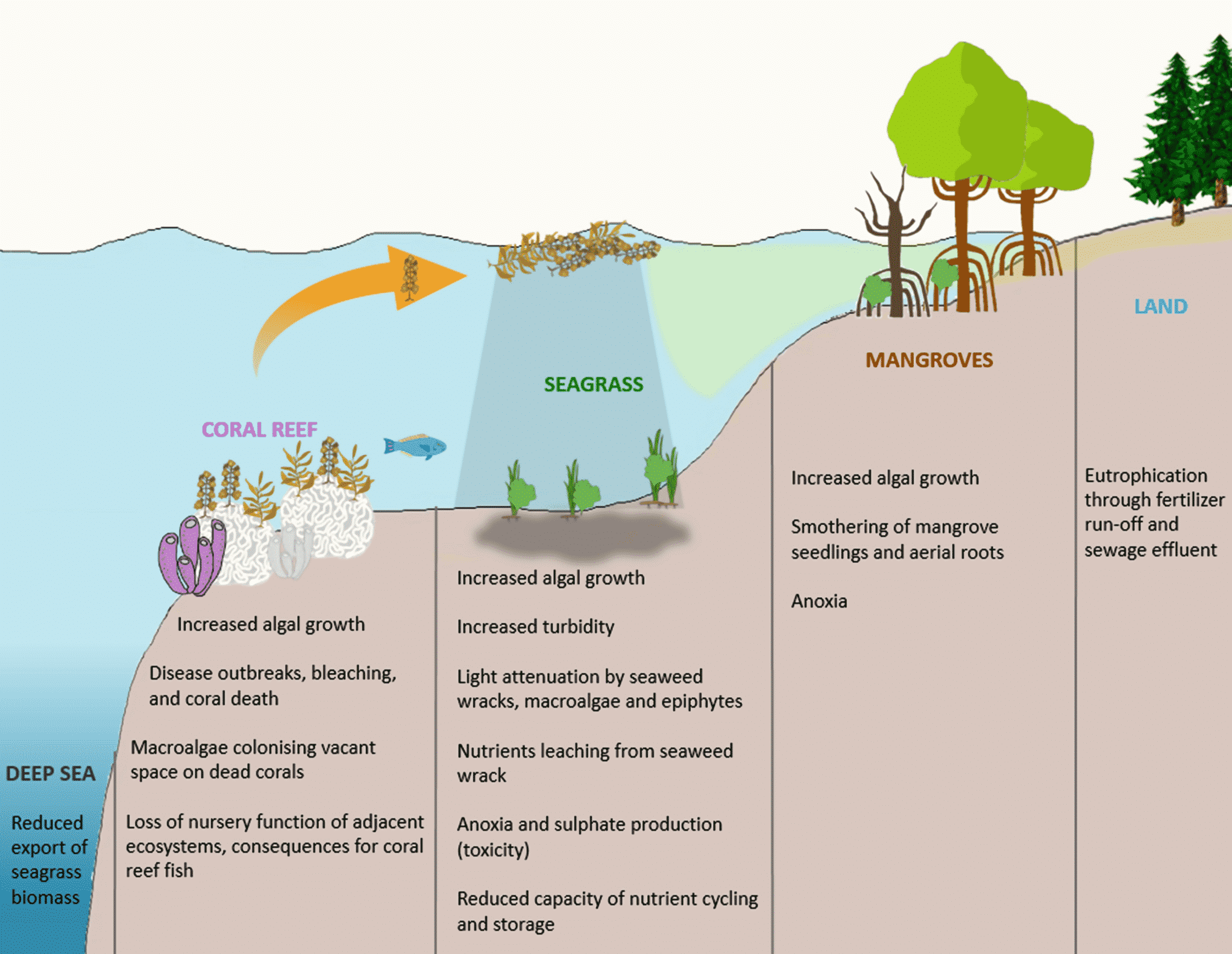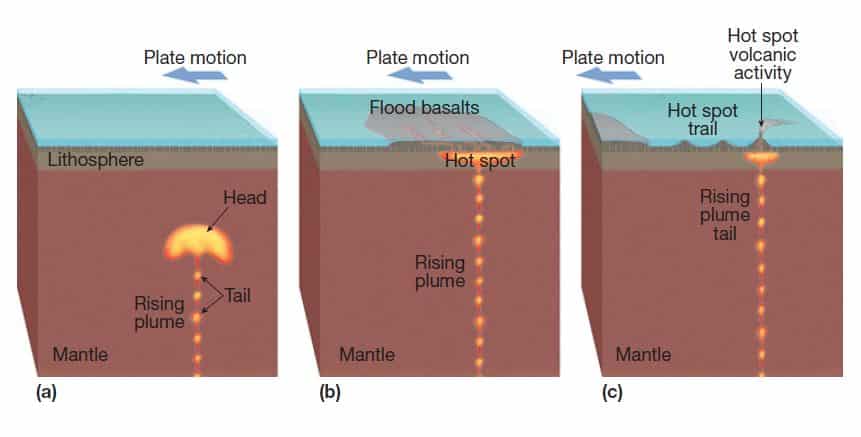Table of Contents
Volcanism, Lava Flows and Volcanic Eruptions | UPSC – IAS
Volcanism or Volcanicity
Volcanism (or igneous processes) is a general term that refers to all the phenomena connected with the origin and movement of molten rock. These phenomena include the well-known explosive volcanic eruptions that are among the most spectacular and terrifying events in all nature, along with much more quiescent events, such as the slow solidification of molten material below the surface.
- When magma is expelled onto Earth’s surface while still molten, the activity is extrusive and is called volcanism; when magma solidifies below the surface it is referred to as intrusive or plutonic activity and results in intrusive igneous features.
Distribution of Earthquakes and Volcanoes | UPSC – IAS
Areas of volcanism are widespread over the world, but their distribution is uneven. Volcanic activity is primarily associated with plate boundaries.
- At a divergent boundary, magma wells up from the interior both by eruption from active volcanoes and by flooding out of fissures.
- At convergent boundaries where subduction of oceanic lithosphere is taking place, volcanoes are formed in association with the generation of magma.
Hot spots are responsible for volcanic and hydrothermal activity in many places such as-
- Yellowstone,
- Hawaii, and
- Galapagos Islands.
Image Explanation:- Distribution of volcanoes known to have erupted at some time in the recent geological past. The Pacific Ring of Fire is quite conspicuous.
It is apparent from Figure that the most notable area of volcanism in the world is around the margin of the Pacific Ocean in the Pacific Ring of Fire also called the Andesite Line because the volcanoes consist primarily of the volcanic rock andesite. About 75 percent of the world’s volcanoes, both active and inactive, are associated with the Pacific Rim.
Volcanic Activity and Eruptions | UPSC – IAS
A volcano is considered active if it has erupted at least once within historical times and is considered likely to do so again. There are about 550 active volcanoes in the world. On average, about 15 of them will erupt this week, 55 this year, and perhaps 160 this decade. Moreover, there will be one or two eruptions per year from volcanoes with no historic activity.
- In addition to surface eruptions on continents and islands, there is a great deal of underwater volcanic activity; indeed, it is estimated that more than three-fourths of all volcanic activity is undersea activity such as at midocean ridge spreading centers. Within the conterminous 48 states prior to the 1980 eruption of Mount St. Helens, there was only one volcano classified as active – Lassen Peak in California, which last erupted in 1917 but still occasionally produces gas and steam.
- A number of other volcanoes, notably California’s Mount Shasta and Long Valley Caldera, Washington’s Mount Baker and Mount Rainier, and the Yellowstone Caldera show signs of potential activity but have not erupted in recorded time, and there are hundreds of extinct volcanoes, primarily in the West Coast states. Alaska and Hawaii have many volcanoes, both active and inactive.
- Active volcanoes are relatively temporary features of the landscape. Some may have an active life of only a few years, whereas others are sporadically active for thousands of years. At the other end of the scale, new volcanoes are spawned from time to time.
Three of the more spectacular recent events were :-
- The birth of Surtsey, which rose out of the sea as a new island above a hot spot off the coast of Iceland in 1964,
- The eruption of an undersea volcano near Tonga in 2009, and
- A new island appearing in the Red Sea in December 2011.
Despite the destruction they cause, volcanoes do provide vital services to the planet. Much of the water on Earth today was originally released as water vapor during volcanic eruptions during the early history of our planet.
Magma also contains elements such as- phosphorus, potassium, calcium, magnesium, and sulfur required for plant growth. When this magma is extruded as lava that hardens into rock, the weathering that releases the nutrients into soil may require decades or centuries. When the magma is ejected as ash, however, nutrients can be leached into the soil within months. It is no coincidence that Java, one of the most volcanically active parts of the planet, is also one of the world’s most fertile areas.
Magma Chemistry and Styles of Eruption | UPSC – IAS
Magma (molten mineral material below the surface) extruded onto Earth’s surface is called lava. The ejection of lava into the open air is sometimes volatile and explosive, devastating the area for many kilometers around; In other cases, it is gentle and quiet, affecting the landscape more gradually. All eruptions, however, alter the landscape because they add new material to Earth’s surface
- During an explosive volcanic eruption, solid rock fragments, solidified lava blobs, cinders, and dust – collectively called pyroclastic material- as well as gas and steam, may be hurled upward in extraordinary quantities. In some cases, the volcano literally explodes, disintegrating in an enormous self-destructive blast.
- The supreme example of such self-destruction within historic times was the final eruption of Krakatau, a volcano that occupied a small island in Indonesia between Sumatra and Java. When it exploded in 1883, the noise was heard 2400 kilometers (1500 miles) away in Australia, and 9 cubic kilometers (2.2 cubic miles) of material was blasted into the air. The island disappeared, leaving only open sea where it had been.
- The tsunamis (great seismic sea waves) it generated drowned more than 30,000 people, and sunsets in various parts of the world were colored by fine volcanic dust for many months afterward.
The nature of a volcanic eruption is determined largely by the chemistry of the magma that feeds it, although the relative strength of the surface crust and the degree of confining pressure to which the magma is subjected may also be important. The chemical relationships are complex, but the critical component seems to be the relative amount of silica (SiO2) in the magma.
Common magmas include :-
- Relatively high-silica felsic magma (which produces the volcanic rock rhyolite and the plutonic rock granite),
- Intermediate-silica andesitic magma (which produces the volcanic rock andesite and the plutonic rock diorite), and
- Relatively low-silica mafic magma (which produces the volcanic rock basalt and the plutonic rock gabbro).
Felsic Magmas | UPSC – IAS
In high-silica felsic magmas, long chains consisting of silicate structures can develop even before crystallization of minerals begins, greatly increasing the viscosity (thickness or “stickiness”) of the magma. A high silica content also usually indicates cooler magma in which some of the heavier minerals have already crystallized and a considerable amount of gas has already separated. Some of this gas is trapped in pockets in the magma under great pressure.
Unlike the more fluid lavas, gas bubbles can rise only slowly through viscous felsic magma. As the magma approaches the surface, the confining pressure is diminished and the pent-up gases are released explosively, generating an eruption in which large quantities of pyroclastic material are ejected from the volcano. Any lava flows are likely to be very thick and slow moving.
Mafic Magmas | UPSC – IAS
On the other hand, mafic magma is likely to be hotter and considerably more fluid because of its lower silica content. Dissolved gases can bubble out of very fluid mafic magma much more easily than from viscous felsic magma. The resulting eruptions usually yield a great outpouring of lava, quietly and without explosions or large quantities of pyroclastic material. (Quietly is a descriptive term that is relative and refers to the nonexplosive flow of fluid lava.) The highly active volcanoes of Hawaii erupt in this fashion.
Intermediate Magmas | UPSC – IAS
Volcanoes with intermediate silica content andesitic magmas erupt in a style somewhat between that of felsic and mafic magmas: periodically venting fairly fluid andesitic lava flows and periodically having explosive eruptions of pyroclastic material. Many of the major volcanoes associated with subduction zones are this type.
Lava Flows | UPSC – IAS
Whether originating from a volcanic crater or a crustal fissure, a lava flow spreads outward approximately parallel with the surface over which it is flowing, and this parallelism is maintained as the lava cools and solidifies. Although some viscous flows cling to relatively steep slopes,
- The vast majority eventually solidify in a horizontal orientation that may resemble the stratification of sedimentary rock, particularly if several flows have accumulated on top of one another.
- The topographic expression of a lava flow, then, is often a flat plain or plateau.
- The strata of sequential flows may be exposed by erosion as streams usually incise very steep-sided gullies into lava flows.
- The character of the flow surface varies with the nature of the lava and with the extent of erosion, but as a general rule the surface of relatively recent lava flows tends to be extremely irregular and fragmented.
Columnar Basalt | UPSC – IAS
One of the most distinctive of all volcanic landscape features commonly develops from flows of fluid lava such as basalt. When such a lava flow cools uniformly, it contracts and forms a distinctive pattern of vertical joints (cracks in the rock), leaving prominent hexagonal columns known as columnar basalt. Devils Postpile near Yosemite National Park in California, and the Giant’s Causeway- or Clochán an Aifir- in Northern Ireland are famous examples of columnar basalt.
Flood Basalt | UPSC – IAS
Many of the world’s most extensive lava flows were not extruded from volcanic peaks but rather issued from fissures associated with hot spots. The lava that flows out of these vents is nearly always basaltic and frequently comes forth in great volume. Many scientists think that the initial consequence of a large mantle plume reaching the surface can be a huge outpouring of lava.
- The term flood basalt is applied to the vast accumulations of lava that build up, layer upon layer, sometimes covering tens of thousands of square kilometers to depths of many hundreds of meters.
- A prominent example of flood basalt in the United States is the Columbia Plateau, which covers 130,000 square kilometers (50,000 square miles) in Washington, Oregon, and Idaho.
- Larger outpourings are seen on other continents, most notably the Deccan Traps of India (520,000 square kilometers [200,000 square miles];
- Trap is derived from the Sanskrit word for “step” in reference to the layers of lava flows found here. Over the world as a whole, more lava has issued quietly from fissures than from the combined outpourings of all volcanoes.
Research indicates that – the timing of several major flood basalt eruptions in the geologic past correlate with mass extinctions of plants and animals – perhaps caused by the environmental disruption brought by the massive lava flows and “out-gassing” (release of volcanic gases) from the eruptions.
For example, some scientists now think that the major extinctions about 65 million years ago that ended the reign of the dinosaurs were as much, or more, a consequence of the flood basalt eruptions of the Deccan Traps than of the asteroid impact that occurred at the same time.
Volcanic Peaks – (Volcanoes names and locations) | UPSC – IAS
Volcanoes are surface expressions of subsurface igneous activity. Often starting small, a volcano may grow into a conspicuous hill or a massive mountain. Many volcanic peaks take the form of a cone that has a symmetrical profile. A common denominator of nearly all volcanic peaks is a crater normally set conspicuously at the apex of the cone. Frequently, smaller subsidiary cones develop around the base or on the side of a principal peak, or even in the crater. Generally, differences in magma, and therefore eruption style, result in different types of volcanic peaks:-
Shield Volcanoes | UPSC – IAS
Basaltic lava tends to flow quite easily over the surrounding surface, forming broad, low-lying shield volcanoes, built up of layer upon layer of solidified lava flows with relatively little pyroclastic material.
- Some shield volcanoes are massive and very high, but they are never steep-sided
The Hawaiian Islands are composed of numerous shield volcanoes. Produced by the Hawaiian “hot spot,” Mauna Loa on the Big Island of Hawaii is the world’s largest volcano. It is more than 9 kilometers (6 miles) high from its base on the floor of the ocean to the top of its summit. Kıˉlauea, currently the most active of the Hawaiian shield volcanoes, is on the southeast flank of Mauna Loa.
Composite Volcanoes | UPSC – IAS
Volcanoes that emit higher silica “intermediate” lavas such as andesite often erupt explosively and tend to develop into symmetrical, steep-sided volcanoes known as composite volcanoes or stratovolcanoes.
- These mountains build up steep sides by having layers of ejected pyroclastics (ash and cinders) from explosive eruptions alternate with lava flows from nonexplosive eruptions.
- The pyroclastic material tends to produce the steep slopes, whereas the solidified lava flows hold the pyroclastics together. Famous examples of composite volcanoes include Mt. Fuji in Japan, Mt. Rainier in Washington, and Volcán Popocatépetl near Mexico City.
Lava Domes | UPSC – IAS
Lava domes – also called plug domes – have masses of very viscous lava such as high-silica rhyolite that are too thick and pasty to flow very far. Instead, lava bulges up from the vent, and the dome grows largely by expansion from below and within.
- The Mono Craters are a chain of young rhyolitic plug domes just to the east of the Sierra Nevada and Yosemite National Park in California – the most recent activity taking place just a few hundred years ago.
- Lava domes may also develop within the craters of composite volcanoes when viscous lava moves up into the vent. Shortly after the large eruption of Mount St. Helens in 1980, such a lava dome began to develop.
Cinder Cones | UPSC – IAS
Cinder cones are the smallest of the volcanic peaks. Their magma chemistry varies, but basaltic magma is most common.
- They are cone-shaped peaks built by the unconsolidated pyroclastic materials that are ejected from the volcanic vent. The size of the particles being ejected determines the steepness of the slopes.
- Tiny particles (“ash”) can support slopes as steep as 35 degrees, whereas the larger ejecta (“cinders”) will produce slopes up to about 25 degrees.
- Cinder cones are generally less than 450 meters (1500 feet) high and are often found in association with other volcanoes. Lava flows occasionally issue from the same vent that produces a cinder cone.
Calderas | UPSC – IAS
Uncommon in occurrence but spectacular in result is the formation of a caldera, which is produced when a volcano explodes, collapses, or does both.
- The result is an immense basin-shaped depression, generally circular, that has a diameter many times larger than that of the original volcanic vent or vents. Some calderas are tens of kilometers in diameter.
- North America’s most famous caldera is Oregon’s misnamed Crater Lake. Mount Mazama was a composite volcano that reached an estimated elevation of 3660 meters (12,000 feet) above sea level. During a major eruption about 7700 years ago, the walls of Mount Mazama weakened and collapsed as enormous volumes of pyroclastic material were ejected from the volcano.
The partial emptying of magma chamber below Mount Mazama may have contributed to this collapse. The final, cataclysmic eruption removed—by explosion and collapse— the upper 1220 meters (4000 feet) of the peak and produced a caldera whose bottom is 1220 meters (4000 feet) below the crest of the remaining rim. Later, half this depth filled with water, creating one of the deepest lakes in North America.
- A subsidiary volcanic cone has subsequently built up from the bottom of the caldera and now breaks the surface of the lake as Wizard Island. Other major calderas in North America include California’s Long Valley Caldera, and the Yellowstone Caldera in Wyoming.
- Shield volcanoes may develop summit calderas in a different way. When large quantities of fluid lava are vented from rift zones along the sides of a volcano, the magma chamber below the summit can empty and collapse, forming a relatively shallow caldera.
- Both Mauna Loa and Kıˉlauea on the Big Island of Hawaii have calderas that formed in this way.


